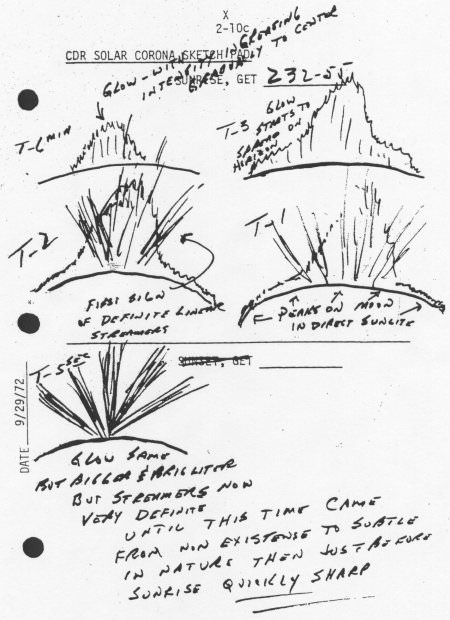[/caption]
There are times when Moon appears to have a tenuous atmosphere of moving dust particles that are leaping up from and falling back to the Moon’s surface. First seen during the Surveyor and Apollo eras, these observations were completely unexpected, and scientists today are still trying to understand this phenomenon.
The first indication that something strange was going on with the lunar surface was in the 1960’s when cameras on the Surveyor spacecraft pointing towards the western horizon noticed a brighter hovering cloud that persisted for several hours.
“There are many other bits and pieces of observations of this kind,” said Dr. Mihaly Horanyi from the University of Colorado Boulder’s Laboratory for Atmospheric and Space Physics. “For example, the astronauts in the Apollo command modules that stayed in orbit about the Moon were hoping to take images of the dark sky, but of course there is scattered light from the dust in interplanetary space. But the brightness also appeared to follow the lunar surface, indicating that somehow dust is coming off the surface of the Moon.”
While astronauts from Apollo 8, 10, and 15 all reported such dust clouds, Apollo 17 in 1972 repeatedly saw and sketched what they called “bands,” “streamers” or “twilight rays” for about 10 seconds before lunar sunrise or lunar sunset.
Adding to the mystery, also on Apollo 17 was a dust detector placed on the surface by the astronauts, the Lunar Ejecta and Meteorite experiment, which was supposed to measure the high speed impacts of micrometeorites hitting the moon.

“Instead the measurements showed an increase of particle fluxes that went up a hundred fold when day turned to night and night turned into day at that location on the Moon,” Horanyi said.
“Every single one of these measurements has an alternate explanation somehow. But it seems that the whole body of these observations is best explained by recognizing that dust — even on an airless body — can move around and come to life.”
Even thought the Moon has no atmosphere, Horanyi said other processes that are likely related to the plasma and radiation environment of the Moon, “the electro-dynamic processes of the near surface lunar environment that can have strong enough electric fields and the surface can have enough electrostatic charges that can break the dust free and somehow shuffle it or move it around the surface.”
In other words, electrostatic charging of the lunar surface causes the dust to levitate, precipitated – somehow – by changes in sunlight.
Horanyi said this type of thing has been seen on other airless bodies, like on Mercury, comets and asteroids.
“For example, the near-landing on the asteroid Eros,”Horanyi said, “people noticed that the bottom of the craters are filled with fine dust, and there is not enough atmosphere, and certainly the body is too small have asteroid shakes – the asteroid version of earthquakes — so the possible transport that would trap or make dust pile up in some regions and move it from others, is most likely a plasma effect.”
Horanyi and other scientists have done lab experiments to try and replicate the lunar environment to see if a dust transport takes place.
“For the first set of experiments, imagine just a piece of surface with dust particles on it, and we shine light on this surface,” he said, “so that half is illuminated, half is not, pretending that there is a terminator region, that the sun is set on one side and is still shining light on the other. When you shine light on the surface with properties that are appropriate, you can emit photo electrons, but you only emit electrons from the lit side, and some of those electrons land on the dark side, — you have a positive charge surplus on the lit and a negative charge pile-up on the night side. Across a couple of millimeters you can easily generate a potential difference of maybe a watt, or a handful of watts, which translates actually as a small-scale, but incredibly strong electric fields. This could be like a kilowatt over a meter. But of course, it only exists over a sharp boundary, and that sharp boundary may be the key to understanding how you get dust moving to begin with.”
Horanyi said in the transient region where boundaries match up – lit and dark boundaries, or boundaries between where the surface is exposed to a plasma and where it is not – those sharp transitions could actually overcome adhesion between dust and the rest of the surface and start moving.
“And that’s where the story gets really interesting,” he said.
Hopefully, a new mission called LADEE (Lunar Atmosphere and Dust Environment Explorer) can help explain this mystery. It is slated to launch in 2013 and fly in low lunar orbit, as close to the surface as 30-50 km. Since NASA may not be sending astronaut to the Moon anytime soon, LADEE’s mission may now be a little different than previously thought, but it still has some important science to conduct.
It will carry three instruments, an infrared imager, a neutral mass spectrometer and a dust detector, which Horanyi is helping to build.
“That hopefully will be capable of measuring tiny, tiny, small particles that people argue are lofted from the surface,” Horanyis said. “And we hope that in combination these instruments might put an end to this argument that we’ve had since the early 1970’s whether dust is really actively transported and shuffled around on the lunar surface or not.”

